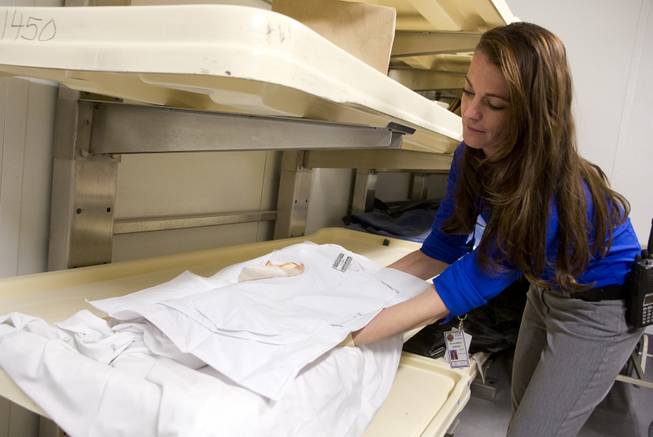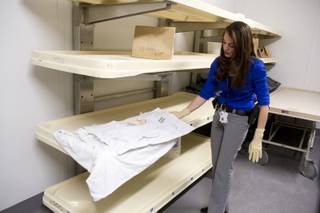
Clark County Coroner Investigator Felicia Borla handles a two-foot long body bag containing remains of newborn Baby Girl “Ren” Doe Thursday, Feb. 13, 2014 at the Clark County Coroner’s Office. Baby Girl “Ren” Doe was found stuffed inside a dumpster outside Planet Hollywood back in Oct. of 2013.
Sunday, March 16, 2014 | 2 a.m.
Most people call her the Planet Hollywood Baby. But at the Clark County Coroner’s Office, the newborn child who was found last fall outside the Las Vegas resort is Baby Girl “Ren” Doe, a name that refers to the RenU Oil garbage collectors who found her corpse shoved into a trash container.
Early autopsy results revealed Ren likely died moments after taking her first breath on Oct. 21, making her the youngest unidentified person examined by the coroner’s office in at least 15 years. Questions linger four months after she was disposed of in an alley along the packed Las Vegas Strip — a tourist-heavy corridor nestled in a transient city where it’s easy to hide.
What killed the seemingly healthy 9-pound, 18-inch baby? Who are her parents? And why was she abandoned?
Investigators are stumped.
“Poor baby Ren — nobody knows her face,” said Felicia Borla, one of several investigators at the coroner’s office who have taken special interest in the case. “She doesn’t have a family or friends who had memories of her. We just know she was Caucasian and that she had a little tuft of black hair on her head.”
The coroner’s office scoured the area for clues and interviewed Planet Hollywood housekeepers, casino managers, garbage collectors, tourists and passers-by.
Did anyone know a pregnant loved one who suddenly went missing? Did a sister, aunt, mother or friend gain considerable weight over a few months?
“Did anybody feel something hinky?” Borla said.
No answers about Ren have emerged.
No. 13-9869
Identifying newborns is difficult because children so young have few individual features. Except for her hair, Ren isn’t much different from any other white baby her age. Investigators don’t know what color her eyes are, as most people are born with pale eyes that change gradually.
Unclothed and with her umbilical cord still attached, Ren’s tiny body was wrapped in a bath towel and packed into a plain trash bag.
The lack of immediate leads is frustrating to investigators, but not every resource has been exhausted.
Forensic examiners have taken a DNA sample from Ren so police can search for matches on the Combined DNA Index System, a nationwide database maintained by the FBI that keeps DNA samples from people convicted of certain federal crimes such as sexual assault and homicide.
“If mommy and daddy are running amok, it could give us a clue,” Borla said. The database will be scanned weekly for DNA matches, so if her parents or siblings run into serious trouble with the law later, CODIS can find them.
That’s the department’s best shot at finding relatives of Ren, who is identified in the lab as Case No. 13-9869 — a numeral designated to Ren based on the order that the coroner’s office received her doll-size body.
For now, Ren is preserved in a small body bag at the coroner’s cold chamber until autopsy results are finalized and a DNA profile is created, a lengthy process that forensic supervisor Wiliam Gazza estimates will take weeks.
“We need all the viable information she can offer,” Gazza said. “We don’t want anything to happen to her until we get her DNA profile.”
What’s your name?
Ren’s is one of 203 unidentified cases in the county dating to 1969. Of those bodies, fewer than 10 are children younger than 3 years old. Some are full-term fetuses.
“We work those cases forever,” Gazza said. “Even after we’ve exhausted leads and resources.”
The department generally revisits each cold case at least once every two years — different sets of investigators take turns analyzing a death with the hope that new leads will materialize. The office also re-examines old evidence using new technology, if it’s available.
“We might run fingerprints on a national system — some algorithms might be more sophisticated. It’s not uncommon for us to get a hit,” Coroner Mike Murphy said. “The light of hope burns eternally bright.”
Only about 10 percent of bodies investigated by the coroner’s office take longer than two weeks to identify. But for an office that handles 29 deaths per day on average, cold cases quickly add up.
A key resource for identifying people is the National Missing and Unidentified Persons System, or NAMUS — a public website with a searchable repository of cold cases.
Murphy helped launch NAMUS after starting a local version in 2003, and he credits both projects for helping identify 70 people since then.
The coroner considers the project his legacy.
“If tomorrow was my last day and that was the only accomplishment we had during my tenure, I would consider that a success,” Murphy said.
Ren’s identification potential via NAMUS is low, and adding her to the website is a long shot. But often the flimsiest tips unravel leads and crack the toughest cases.
Baby Cordova
Consider Jane “Cordova” Doe, a 3-year-old girl found dead in a trash bin eight years ago at the Villa Cordova Apartments in Las Vegas.
A man who was scrounging for used electronics found the infant on Jan. 12, 2006, initially mistaking her for a doll. Through NAMUS, the coroner’s office released composite images of the girl wearing a white fleece jacket embellished with pink hearts. A nationwide search for information began, and hundreds of tips poured in from across the country, Canada and Mexico until finally a call came from the child’s grandmother in California. She recognized not the composite image of the child’s face, but her distinctive outfit.
The infant was named Crystal Figueroa.
“It’s spotty, but it’s unlike anything else,” Murphy said of the rudimentary NAMUS system.
Burying Ren
Once enough data has been taken from Ren’s body, the coroner’s office will begin the burial process. Valley Funeral Home manager Mimi Abe can then prepare arrangements.
Ren will have her own casket there, but she may have to share a plot with two other unclaimed bodies once a cemetery has been selected.
The shared burial spots contain costs, Borla said. Cremations are cheaper, but the coroner wants to keep open the option of exhuming her, if need be.
Perhaps someone will eventually want to claim her.
“It’s in the heart of a lot of people,” Borla said. The workers at RenU Oil, for example, call investigators regularly for updates on Ren’s case.
“She might not have been loved by whoever threw her in a dumpster,” Borla said. “But she’s loved by the community.”
Purpose after death
Borla wonders why Ren’s mother didn’t just give the child up to someone else.
Was Ren’s mom a victim of sex trafficking? Was she in the country illegally? Was she a teenager?
Perhaps the newborn’s story will serve to remind Nevadans about the state’s Safe Haven Law, which allows parents of children younger than 30 days to legally relinquish custody by leaving them at a hospital, obstetric center, fire station or law enforcement agency.
“In some way we might be able to prevent this from happening again,” Borla said. “Maybe her purpose will be to save other lives.”
Tipsters with information about Ren are urged to call the coroner’s office at 702-455-3210. People can also call Metro’s Homicide Division at 702-828-3521 or, to leave information anonymously, call Crime Stoppers at 702-385-5555.


Join the Discussion:
Check this out for a full explanation of our conversion to the LiveFyre commenting system and instructions on how to sign up for an account.
Full comments policy